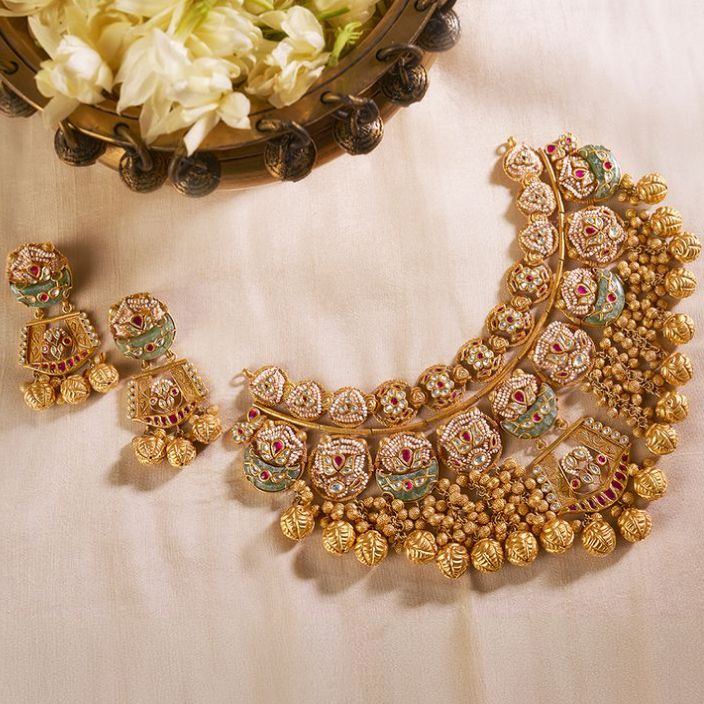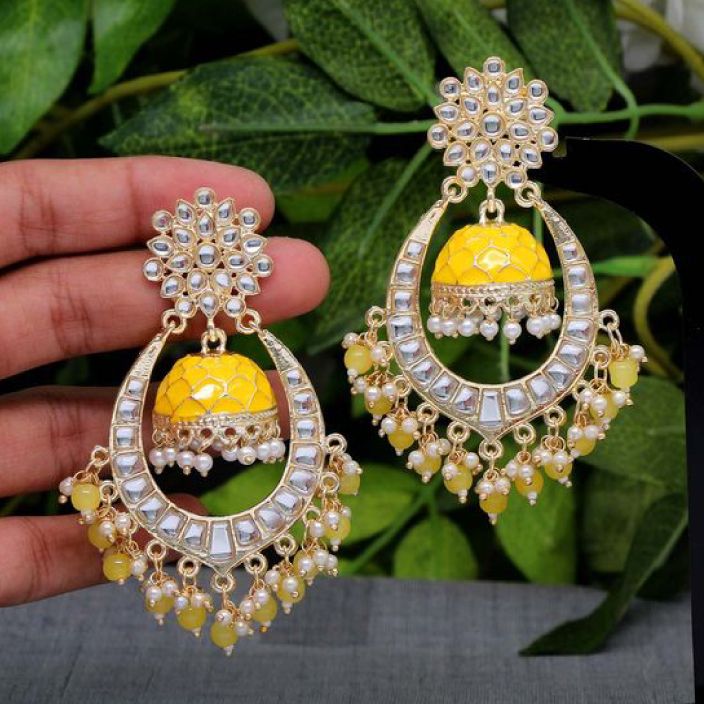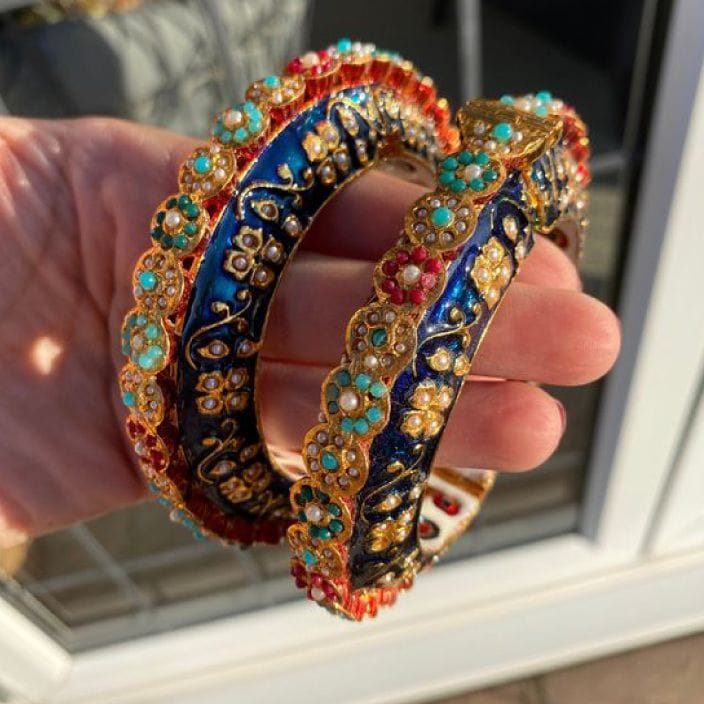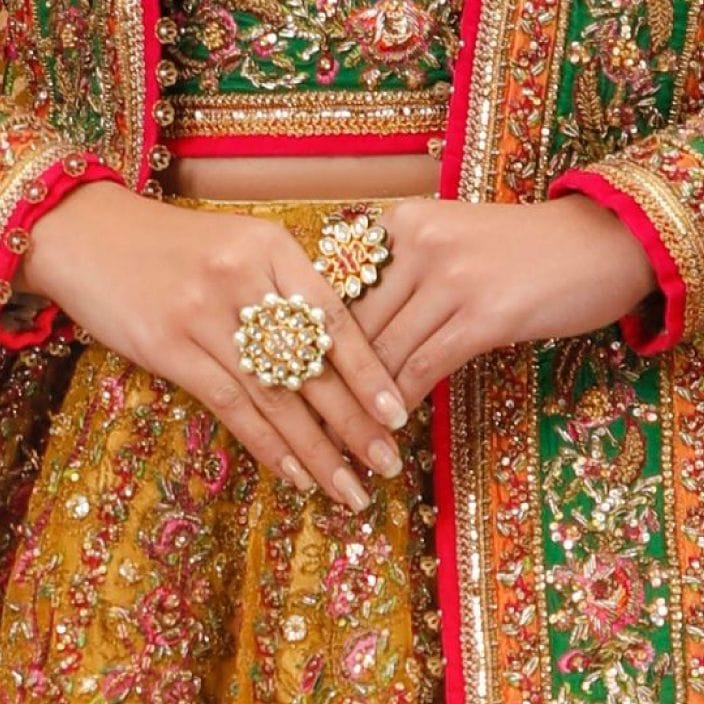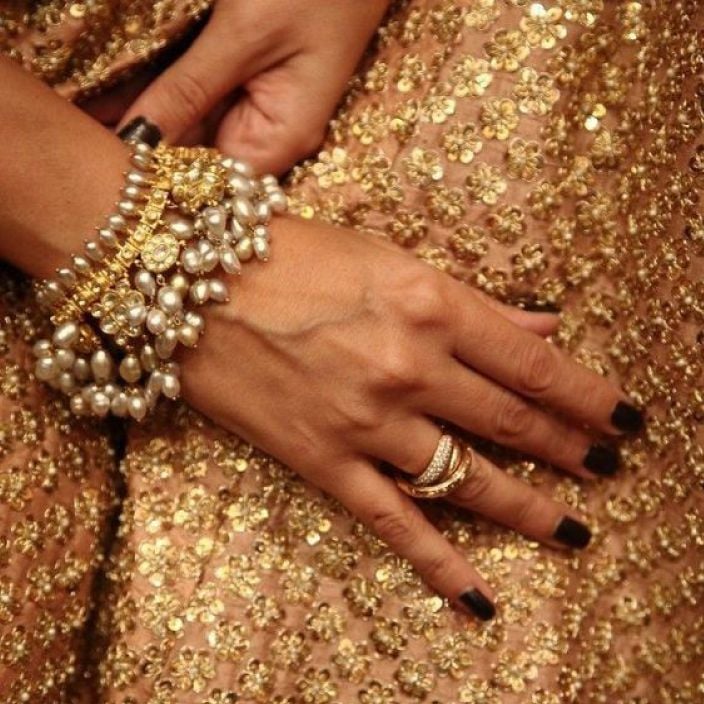For best prices and early deliveries, WhatsApp us at. 918488070070
Meenakari Jewellery
Meenakari, or Minakari, is a form of enamelling metals and tiles. The ancient art can be traced back to the Parthian and Sassanid empires of Persian history that ruled from 247BCE to 651CE before being overthrown by the Arab Rashidun Caliphate. Formed from two original Persian words –. M?n? or Meena meaning paradise, and k?r? meaning work on an object; M?n?k?r? or Meenakari means placing paradise on an object. Found in jewellery, utensils, and decorative metal objects, the beautiful art of etching and colouring with enamel involves intricate geometric designs in vivid hues. The history of Meenakari dates back to the 16th century when this original art form found its way to India and later spread to Pakistan, Afghanistan, China, Greece and Russia. The Moghul emperor Akbar first introduced Meenakari work in India. The artisans decorated thrones, ceilings and walls in the royal palace. Soon, Raja Man Singh of Amber brought the craft to Jaipur, Rajasthan, where artisans improved and excelled in Meenakari jewellery making. From the 16th through the 19th century, the art form gathered recognition as Mughal and Rajputana royalty began to purchase and wear Meenakari jewellery. The intricate designs showcased flowers, leaves, elephants, peacocks, parrots and paisley patterns set with precious and semi-precious stones, including pearls, diamonds, rubies, and emeralds. Today, different styles of meenakari jewellery, such as Khula Meena, Band Meena, Panchranga Meena, Gulabi or Banarasi Meena, represent regional diversification of the art. Meenakari jewellery manufacturers and exporters have established a thriving business employing thousands of highly skilled kaarigars in Rajasthan, Gujarat, West Bengal and Uttar Pradesh.
The Making of Meenakari Jewellery
The process of creating Meenakari jewellery is time-consuming. It uses the age-old method of coating the metal surface with a mixture of metal oxides and glass burned at high temperatures. There are two basic styles used in the process of making Meenakari jewellery. The first is the "Ek Rang Khula" style, which uses a single colour of enamel throughout the design, and the second is "Panchrangi Meena" style, which combines five different colours.
The first step in Meenakari is to prepare the base metal for enamelling – gold, silver or copper. The goldsmith, kaarigar or sonar fixes the jewellery piece on a lac stick. He removes any dirt, oil, or grease with a cleaning agent. He also uses fine sandpaper or steel wool to texture the surface.
He then hands it over to the chhatera, who draws and engraves the salai or pattern onto the gold jewellery using a small chisel or burin and a fine-tipped steel brush. The chhatera etches or engraves delicate designs of flowers, birds, fish, etc. on to the surface, making micro walls or grooves to hold colour.
Depending on the design, the Meenakar prepares the enamel colours. He either sifts a dry colour on the surface or applies a wet colour paste. After the enamelling, he places the ornament in a kiln at 750-850 degrees centigrade. This process is repeated for each colour. As a rule, white is applied first and red last.
After the last colour is fired, the ornament is completely cooled, checked for imperfections, cleaned and polished with agate.
It then goes back to the kaarigar and the patua. The kaarigar removes the ornament from the lac stick, cleans, polishes and adds components such as earring hooks or necklace chains. A patua strings together pearls, beads and tassels.
Meenakari is a labour-intensive and time-consuming process. Red, green and white are the most prominent colours of enamel. Jaipur enamelling technique is known for its rich ruby red colour called Champlevé. Similarly, Meenakari from Varanasi is characterised by pink-on-white enamel.
Cultural Significance
Meenakari jewellery represents India’s rich cultural heritage. From the Moghul courts to Rajput royalty, it spells opulence. The jewellery has aspects such as history, symbolism, and craftsmanship that hold cultural significance and set it apart from other kinds of jewellery.
The history of Meenakari jewellery goes back to the Parthian and Sassanid empires of Persia. Later, in the 16th century, during the reign of Emperor Akbar, Meenakari jewellery found its way to India. The significance of Meenakari work lies in its vibrant designs, which symbolize the rich cultural heritage and artistic excellence of traditional craftsmanship. Since then, it has delighted jewellery collectors with its original designs, colours and fine craftsmanship.
The dramatic motifs on Meenakari jewellery express spirituality. Motifs like lotus, peacock, and paisleys associated with specific deities have religious connotations and are considered bearers of good luck.
Also, the method of making meenakari jewellery has not changed much. Skilled Meenakars have passed on the knowledge and skill to their generations, ensuring the process lives on.
Evolution & Adaption
Meenakari is an integral part of Rajasthan’s artistic heritage. Despite modernisation, the craftsmanship of Meenakari jewellery has not undergone major changes. Today, there are modern adaptions of Meenakari necklaces, bangles, rings and earrings but without losing their cultural significance or artistic excellence.
The art experienced a decline during the colonial period but revived again, owing to patrons like Sabyasachi, who popularised meenakari work in bridal jewellery. The vibrant Meenakari jewellery, available in gold, silver, white metal and imitation, has become a favourite across generations.
